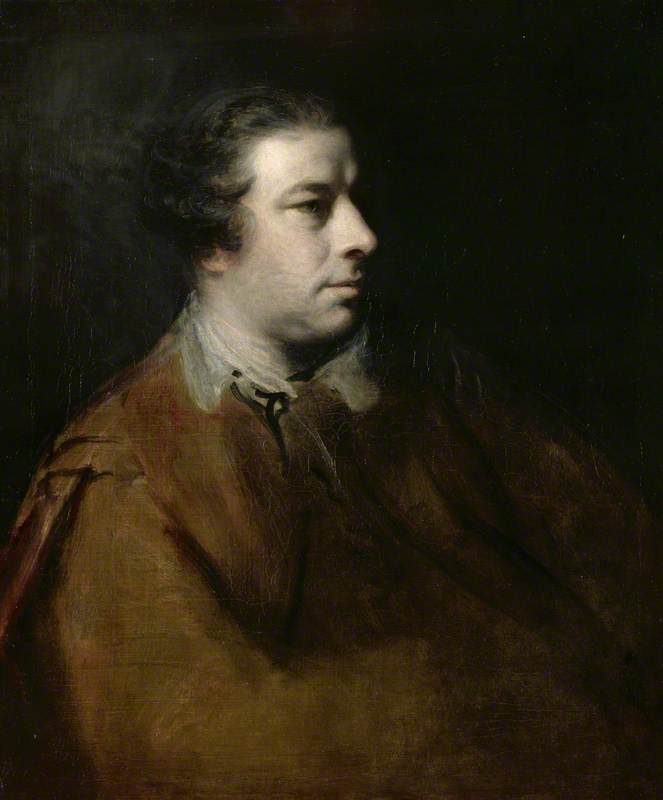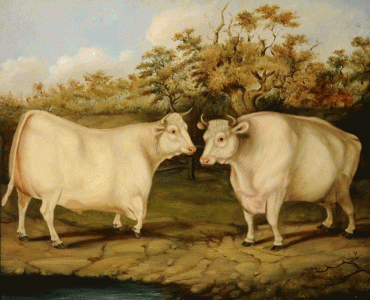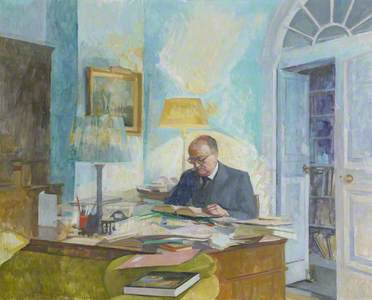I have been asked by Andy Ellis, the Director of Art UK, to write about the experience and pleasures of making use of the new facility which is available to users of the Art UK website. As a way of celebrating the RA’s 250th anniversary, it is now possible to find out where works by Royal Academicians are located. You go to the Art UK website, enter the words ‘Royal Academician’ in the search engine, select the ‘Royal Academian’ tag, and there you will find a comprehensive listing of over 25,000 artworks which one can order by artist, date, and, perhaps best of all, filter by location. A map allows you to find out what works by Royal Academicians are held, for example, in Anglesey and East London. One can also search using the tag 'President of the Royal Academy' to see a list of nearly 2,000 artworks by PRAs.
My immediate instinct on having access to this wonderful facility was to check what works by RAs are held by Cambridge colleges. This is because, from the moment that Art UK was first established as the Public Catalogue Foundation, the issue as to how far the Cambridge colleges were incorporated into the listings was an issue much discussed and debated by the early Trustees, of which I was one (I was a Trustee from 2003 to 2015).
In terms of listing the holdings of The Fitzwilliam Museum, the Cambridge University Museum, the issues were straightforward. In fact, it was the experience of visiting The Fitzwilliam Museum and finding that its holdings were not publicly available which had led to the establishment of the Public Catalogue Foundation (now Art UK) in the first place. A printed catalogue was published in 2006 with an introduction by Duncan Robinson, its then Director, celebrating the fact that it contained a complete inventory of the 1,540 oil paintings owned by the Museum, including additions to the collection since the publication of its three-volume printed catalogues in the 1960s.
Not surprisingly, The Fitzwilliam Museum contains a wealth of work by Royal Academicians, beginning with work by some of the founding fathers of the RA, including four works by Sir Joshua Reynolds, the first President – an early portrait of Henry Vansittart, on his return to England from India, Mrs Angelo, whose husband, Domenico, ran a fashionable riding school, an unfinished portrait of Lord Rockingham and Edmund Burke and a late group portrait of The Braddyll Family – and nine by Thomas Gainsborough RA, including a portrait of John Kirby and his wife and the beautiful portrait of Heneage Lloyd and His Sister, Lucy, the two children of Sir Richard Lloyd in the gardens of Hintlesham Hall. There are major Victorian works: the portrait of Archdeacon John Fisher by John Constable RA, a Self Portrait by George Richmond RA and the portrait of The Twins, Kate and Grace Hoare, painted by John Everett Millais RA. And there are fine works from the early twentieth century, including a good group of Augustus Johns and Lytton Strachey by Henry Lamb RA.
When it comes to the listing of works owned by the colleges, issues became more complicated, because the collections of colleges are regarded, for good reasons, as private assets of the colleges themselves, which are not necessarily made available to the public and where there may be understandable anxieties about the risk of theft through publicity about what they own. Several of the colleges initially refused to allow their works of art to be listed in a book that was described as ‘The Public Catalogue Foundation’.
Whereas, of course, the collections of colleges are held in trust by their fellowship and, as such, are private assets, the colleges are also, at the same time, charities, which owe their charitable status to their significant responsibilities for education, scholarship and research. As such, they may have a responsibility to make the works of art they own at least available for public inspection, which includes allowing them to be listed for the benefit of scholars and the wider public.
The great majority of the Cambridge colleges have now agreed to this, which means that their works are now searchable through Art UK and one can as a result, for example, find out what works they own by Royal Academicians.
St John’s College, for example, has 24: portraits of alumni, including William Wordsworth by H. W. Pickersgill RA and William Wilberforce by George Richmond RA; and portraits of their Presidents, including the excellent, relatively recent portrait of the mathematician, Peter Goddard, by Tom Phillips RA.
Christ’s College, of which I am an Honorary Fellow, has five works by RAs: a portrait of William Paley, the great natural theologian, by William Beechey RA and of Charles Robert Darwin by Walter William Ouless RA; and three modern portraits of masters, including Sir John Harold Plumb by Lawrence Gowing RA (I was a member of the sub-committee which was involved in the selection of Gowing), Sir Hans Kornberg by John Ward RA, and Malcolm McNaughtan Bowie by Tom Phillips RA.
Sir John Harold Plumb (1911–2001), Master (1978–1982), Professor of Modern English History
c.1979
Lawrence Gowing (1918–1991) 
Trinity Hall, which was one of the first of the colleges to sign up owing to the generous support of its then Master, Martin Daunton, not only has a collection included in Art UK, but, very admirably, also has an illustrated Informal Guide to its portraits, freely available on the web. This gives a good sense of the college and its place in public life. There is a terrific portrait of a former Master, Henry Bond, by Gerald Kelly RA, who was a President of the RA in the early 1950s and, I discover, a graduate of Trinity Hall; a rather saturnine portrait of Dr Louis C. G. Clarke, who was a Director of the Fitzwilliam Museum from 1937 to 1946, by Augustus Edwin John RA; and two good seascapes by Hughie O’Donoghue RA, a current Academician.
What this brief browse through the collections of the Cambridge colleges demonstrates is how useful it is to be able to have access to their collection as a way of providing a brief overview of their history: who were their key figures, their most prominent graduates, their Masters, and sometimes their most distinguished honorary fellows. They have a long and honourable tradition of collecting and also, frequently, commissioning portraits, which, unusually, continues today.
It is a tradition worth celebrating and certainly deserves to be documented, as it has by Art UK.
Charles Saumarez Smith, Secretary and Chief Executive of the Royal Academy of Arts and Honorary Trustee of Art UK















